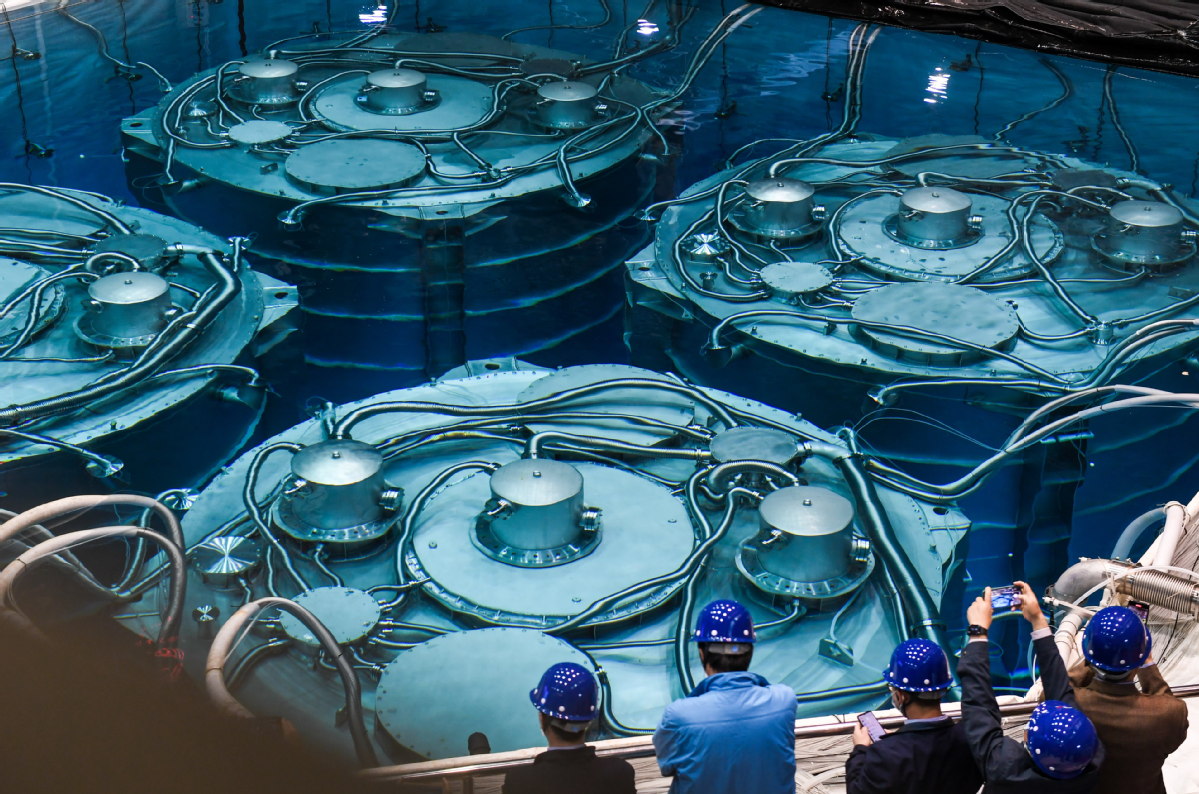Ghost particle probe marks end of an era
By ZHANG ZHIHAO in Shenzhen, Guangdong | China Daily | Updated: 2020-12-14 09:15

Shenzhen facility decommissioned after 9 years of research into universal puzzle
Chinese scientists have decommissioned the Daya Bay Reactor Neutrino Experiment in Shenzhen, Guangdong province, bidding farewell to a major scientific instrument responsible for one of China's biggest discoveries in physics that may help explain why the universe is the way it is.
A mission completion ceremony was held on Saturday at the facility, which was first conceived in 2003. Launched in 2011, the instrument has finished all its research missions and produced valuable data with unprecedented precision.
China's next-generation neutrino detector-the Jiangmen Underground Neutrino Observatory, or JUNO-is being built 700 meters underground in Jiangmen, Guangdong. The 2 billion yuan ($305.3 million) instrument is expected to be completed around 2022, with around 680 researchers from 18 countries and regions participating in the project.
The new machine aims to detect and measure neutrinos with unprecedented precision and energy resolution, hoping to uncover more insights on their mass, how they can change identities midflight in a process called oscillations and solve more mysteries about the perplexing elementary particle, which is both extremely abundant and difficult to spot.
The engineering breakthroughs that made observation possible can also benefit society and industries in the form of ultrasensitive light detectors, new manufacturing techniques and standards for high-performance steel and glass, and ultraclean water for the semiconductor industry.
"The Daya Bay Reactor Neutrino Experiment laid the foundation of China's international cooperation in neutrino-related particle physics and paved the theoretical groundwork for new neutrino observatories being built in China and around the world," said Wang Yifang, director of the Chinese Academy of Sciences' Institute of High Energy Physics.
A neutrino is a subatomic particle produced by radioactive decay, a process commonly found in the nuclear reactions of our sun or in nuclear power plants. It carries no electrical charge and has minuscule mass, at least a million times smaller than an electron, Wang said, "yet it is a fundamental building block of our physical reality."
These properties allow neutrinos to penetrate most matter and rarely interact with any of them, not even with light. Hence, the particle cannot be felt or seen despite trillions of them passing through our bodies at near-light speed every second, Wang said. Therefore, the neutrino is also humorously referred to by scientists as the ghost particle.
What is more perplexing about the particle is that since its discovery in 1956, scientists have found three different types, or "flavors", of neutrinos that can transform into one another when traveling through space. After decades of experiments, scientists had measured two of the three "mixing angles" which, crudely speaking, describe the degree to which one flavor can mix into another.
The final mixing angle was determined by the international team of researchers at the Daya Bay Reactor Neutrino Experiment in 2012. The discovery opened the door to probing whether there is a slight asymmetry between neutrinos and antineutrinos, the mirror image of neutrinos that have the same mass and no charge, but with opposite chirality.
When a particle and its antiparticle collide, they typically annihilate each other and release energy, according to the journal Science. Scientists have theorized that there should be an equal amount of particles and antiparticles produced shortly after the Big Bang, yet for some unknown reasons the universe has evolved to have significantly more matter than antimatter.
The results sent a shock wave through the world's physics community, with the journal hailing it as one of the biggest breakthroughs in 2012. Lee Tsung-Dao, a Nobel laureate in physics, said in a congratulatory letter that it represents a major achievement in physics with key significance for basic research.
"While there have been numerous breakthroughs in our understanding of neutrinos in the past few decades, there are still many questions left unanswered," Wang said. "Answering them may fundamentally change how we understand particle physics and the evolution of the universe."
























